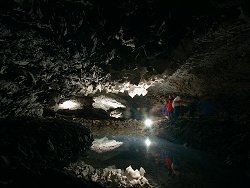Gypsum Caves
Gypsum Karst

 Barbarossahöhle in
Barbarossahöhle in  Germany.
Germany.


Gypsum Karst, as the name says, forms in deposits of gypsum or anhydrite, sometimes also called alabaster. Chemically anhydrite is anhydrous calcium sulfate CaSO4 or "calcium sulfate without water". On the surface rainwater is absorbed by the anhydrite and becomes part of the rock, which now has the chemical formula CaSO4*2H2O. When the anhydrite absorbs water, it transforms into gypsum, increasing its volume by 30-40 %. In general the gypsum is a result of evaporation it is a chemical sedimentary rock, which looses its water content and thus the layers are anhydrite. Only the layers close to the surface transform into gypsum due to rainwater.
Gypsum karst works quite similar to limestone karst, there are caves, dolines, swallow holes, underground drainage and karst springs. The specific thing for karst is, that the rock is dissolved by water and the water moves it away, and the caves form. This is the same for all soluble rocks, like limestone, dolomite, gypsum/anhydrite, and salt. But the solubility of gypsum is quite different to limestone, the amount is much higher, over 2 kg per 1 m³ of water, and it does not require carbonic acid, as does the solution of limestone. The high solubility of gypsum leads to very rapid and large-scale cave development. Caves develop in less than a tenth of the time which they would take in limestone, but they also collapse again all the more quickly. For example, the Barbarossa Cave in Germany is only 200,000 years old.
There is one process forming caves in gypsum, which does not exist in limestone, and is not connected to dissolving. It’s actually a mechanical process based on the increase in volume when the anhydrite transforms into gypsum. If a horizontal layer of some thickness is converted into gypsum it expands, but there is no way to expand horizontally, and as it has a layer of rock below there is also no way downwards. As a result the expansion creates upward folds in the layer with small caves at the center. Those caves are called expansion caves.
Gypsum caves have completely different speleothems, especially there are normally no stalactites or stalagmites at all. Gypsum is soluble by water without requiring carbonic acid, there is no other substance involved in the process. Limestone or calcite speleothems are formed by precipitation, when the limestone saturated water reaches the cave, carbonic acid escapes from the water into the air, as a result the limestone precipitates and forms stalactites and other sinter forms. Gypsum, on the other hand, remains in solution, to make gypsum precipitate, the water has to evaporate, which does not happen in a cave with a humidity of almost 100 %. What happens is the growth of gypsum minerals in standing water, a slow process which creates translucent white or colourless crystals.
Like limestone, gypsum is a "salt" and it is formed by the weathering of rocks and by biological activities. It is mart of the minerals which are dissolved in seawater, and if seawater evaporates, it precipitates. Unlike limestone and quartz, it is not used by animals to form shells or bones, because it is not solid enough, and so there are no gypsum fossils. Also, it is not precipitated in the sea, which happens all the time with limestone, because of its high solubility. There is actually only one known process which produces layers of anhydrite. You need a huge depression, in which seawater is trapped and evaporated to form gypsum deposits. It has to be in an arid part of the world, otherwise the rainwater would revert this process and dissolve it again. There must be a continuous or periodical (sea) water inflow, to allow the deposition of a decent amount of gypsum. If there is no (temporary) connection to the sea, the layer would be rather thin. If the connection is temporary, every time the depression is filled with fresh seawater a new sequence starts. First the carbon dioxide vanishes and limestone is deposited, then the concentration of all the salts in the water grows. At one point the solution is over-saturated and the next salt starts to precipitate, gypsum, then rock salt and finally potassium salt. And while the requirements are rather rare, they actually happened several time during earths history.
Now you have gypsum, but there is another problem: water is able to dissolve gypsum without the complicated carbon dioxide reaction which is necessary with limestone. And it will do it much faster and be able to dissolve a much higher amount! As soon as gypsum layers are in the groundwater zone they are dissolved by the groundwater and transported away. So it is gone at least 10 times faster than a limestone layer would be. In other words: while there is significantly less gypsum than limestone, gypsum is once again much rarer on the earth’s surface. And because it is quickly eroded, it means that it is always very young, when it gets older it disappears. And above all, the caves are extraordinarily large, much larger than one might expect with limestone in a comparable climate.
- Examples
 Gypsum Caves and Mines
Gypsum Caves and Mines

 Index
Index Topics
Topics Hierarchical
Hierarchical Countries
Countries Maps
Maps Search
Search